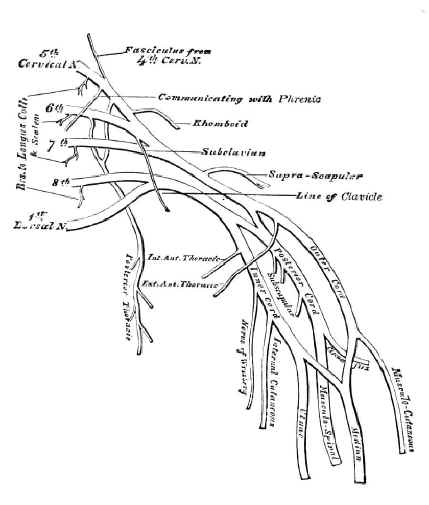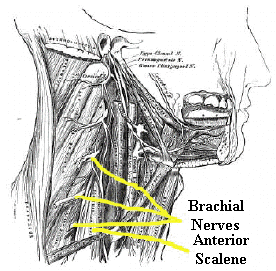BodymindResources.com
Thoracic Outlet Syndrome Theory

Click on the scientist to go to the Thoracic Outlet Lab
Welcome to BodymindResources.com's presentation of the Thoracic Outlet Syndrome class! Today we will be discussing Thoracic Outlet Syndrome, how it happens and how to treat it.
What is Thoracic Outlet Syndrome?
Thoracic Outlet Syndrome is a pinching or pulling of the brachial plexus (a bundle of nerves in the shoulder/neck area). It can also entail a pinching off of an artery that runs underneath the clavicle (subclavian artery). This causes numbness, tingling, or pain in the hands that is often mistaken for Carpal Tunnel Syndrome. The impairment of the brachial plexus or subclavian artery can come about in many different ways. It can happen due to injury, vascular disease, lesions, and many other little things that can go wrong. The most common cause and the one we are concerned with today, however, is a mechanical cause of nerve pinching muscular tension and connective tissue adhesion caused by improper body mechanics and dysfunctional repetitive movements of the arms and rib cage.
What is the Brachial Plexus?

The brachial plexus is a bundle of nerves whose roots begin mainly in the cervical (neck) spine. These roots create a bundle of nerves that start to merge into more organized grouping as they move towards the arms. This bundle of nerves eventually becomes the radial nerve, the ulnar nerve, and the median nerve that we discussed in the Carpal Tunnel class. Since this bundle can become the median nerve, you can see why Thoracic Outlet Syndrome can be mistaken for carpal tunnel. This is because it is often the same impingement just higher up the route of the nerve.
These nerve, like any nerves, when pinched, lose some of their blood flow and ability to transmit impulses. This results in numbness, tingling and/or pain. If you treat this soon enough, you should be able to quickly restore function to the nerve route. If you wait too long you can delay recovery or even permanently damage the nerve so the time to act is always NOW!
What muscles are likely to be pinching the brachial plexus?
If we follow the route of the brachial plexus ,  we see
that it exits the spine front the vertebra of the bottom half of the neck.
From here it comes out in between the anterior and middle scalene muscles
making the anterior scalene a likely culprit. From here is moves
underneath the clavicle making the subclavius muscle a culprit. The
subclavius is a small muscle that lies underneath the clavicle. It has the
capability of squeezing the clavicle tightly towards the first rib.
we see
that it exits the spine front the vertebra of the bottom half of the neck.
From here it comes out in between the anterior and middle scalene muscles
making the anterior scalene a likely culprit. From here is moves
underneath the clavicle making the subclavius muscle a culprit. The
subclavius is a small muscle that lies underneath the clavicle. It has the
capability of squeezing the clavicle tightly towards the first rib.
This
could impinge the brachial plexus. From here is actually travels
underneath the pectoralis minor make this muscle an extremely likely
culprit. Today in the lab portion of this class we will begin the process
of releasing these three muscles.
impinge the brachial plexus. From here is actually travels
underneath the pectoralis minor make this muscle an extremely likely
culprit. Today in the lab portion of this class we will begin the process
of releasing these three muscles.
What causes the tensions that create Thoracic Outlet Syndrome?
Well one thing worth observing is that all three of
those culprit muscles have one thing in common. Each of them attaches to
the rib cage. This tells me that the structural integrity of the rib cage
is a key factor. Any client I have ever had with symptoms of Thoracic
Outlet Syndrome had collapsed the front of their rib cage and was
breathing very shallowly. One must also note that the structure of the rib
cage determines the structure of the arms, head and neck since these
structures must sit on top if the rib cage.  When the front of the rib cage
collapses, the arms, head and neck roll forward off of it. This shortens
the pectoralis minor, subclavius, and puts the anterior scalene in a
awkward position. Add stress and malnutrition, and dehydration to this
equation and it's no wonder you would have problems. If you are constantly
performing actions the bring your arms forward off the rib cage and if you
are allowing the integrity of your rib structure to collapse you stand to
consistently aggravate this nerve plexus.
When the front of the rib cage
collapses, the arms, head and neck roll forward off of it. This shortens
the pectoralis minor, subclavius, and puts the anterior scalene in a
awkward position. Add stress and malnutrition, and dehydration to this
equation and it's no wonder you would have problems. If you are constantly
performing actions the bring your arms forward off the rib cage and if you
are allowing the integrity of your rib structure to collapse you stand to
consistently aggravate this nerve plexus.
We must release these muscles and we must restructure the rib cage to be open at all times. You would benefit from reading Class 4 in the Heal Thyself Series to learn more about the structure of your rib cage. In the lab portion of this class, I will be giving you exercises to help restructure your rib cage. Please understand that the human body does require maintenance. Every other animal on the planet maintains his or her body. The first thing a cat does upon arising from its slumber is stretch. It must do this or its body will become stiff with age. Humans think themselves exempt from this, but they are not. You must stretch to prepare for your work day and you must stretch to undo the stiffness of sleeping. It is vital.
If you already have a difficult case of thoracic outlet syndrome, the techniques for treating it are the same for curing it, but you must take into consideration that these tissues need to have all the necessary nutrients for healing at hand. Please read Class 5 of the Heal Thyself Series to learn some aspects of how to properly care for your body. You must set your body up to be successful and try every other option before resorting to surgery. The human body is very resilient! If you start giving it what it needs to function properly, you will often notice a tremendous difference! Let's go to the Lab.